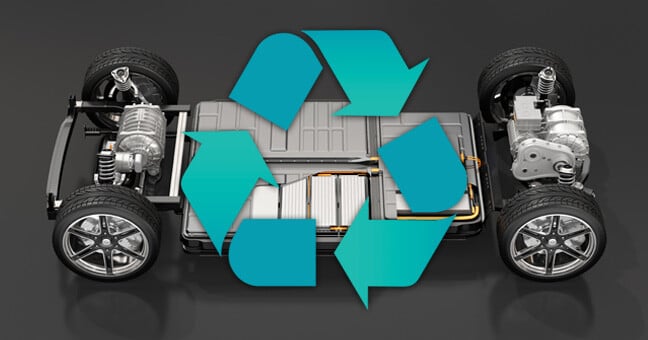

Dec 30 2024
By Haylee Eaton
Lithium-ion batteries, which power both fully electric and hybrid vehicles, are revolutionizing mobility and offering a cleaner alternative to gas-powered, internal combustion-based vehicles. However, a growing challenge lies beneath these batteries’ immediate eco-friendly benefits: recycling and reusing them. Due to the mining of scarce resources, EV battery recycling represents the most expensive component and largest logistical challenge for electric car adoption. A previous DataOne article discussed how EV batteries have a finite lifespan, and recycling can offer a more sustainable end-of-life solution. Understanding the impact of this technology requires examining the full picture – including the benefits of battery recycling, challenges, and drawbacks, and where the future of EV batteries is headed. Addressing these uncertainties today can lay the groundwork for a greener future.
As EV adoption accelerates, their environmental impact extends beyond zero-emissions driving. Recycling EV batteries is pivotal in reducing the strain on finite resources like lithium, cobalt, and nickel. These materials are resource-intensive to extract, and mining them disrupts ecosystems and depletes natural reserves. Recycling helps conserve these critical materials, creating a circular supply chain supporting EVs' long-term sustainability.
In addition to conserving resources, recycling EV batteries significantly lowers the carbon footprint of battery production. Recovering materials like cobalt and lithium requires far less energy than mining and refining raw materials, cutting greenhouse gas emissions substantially. Recycling also prevents hazardous substances from entering landfills, protecting soil and water from contamination. With projections suggesting that recycling could supply up to 25% of lithium and 35% of cobalt demand by 2040, sustainable battery management must become a cornerstone of the EV market.
Despite its benefits, EV battery recycling faces significant challenges. Current battery designs prioritize performance and cost over end-of-life management, making disassembly and material recovery complex and costly. Additionally, many lithium-ion batteries haven’t yet reached the end of their lifespan, meaning recycling technologies are still catching up. Even when batteries are recycled, inefficiencies in existing methods lead to the partial loss of valuable materials, limiting the overall impact.
Another major hurdle is the infrastructure gap. Many recycling facilities were built to handle production scrap rather than used EV batteries, creating a bottleneck as more batteries reach their end of use. Recycling processes, such as smelting and chemical leaching, can also pose environmental risks. For example, smelting releases greenhouse gases, while chemical leaching may generate hazardous waste. Transporting used batteries to centralized facilities further increases emissions, offsetting some of the environmental gains. Addressing these challenges is essential to maximizing the benefits of recycling.
The future of EV battery recycling is defined by innovation and the urgent need for scalable solutions. Global battery demand is expected to grow by over 600% by 2030, which means the existing supply chain is under immense pressure. Materials often travel tens of thousands of miles before reaching manufacturers, increasing costs and emissions. U.S. cell manufacturers alone are projected to spend over $600 billion on materials over the next decade, highlighting the need for localized and efficient recycling infrastructure.
Advancements in recycling technologies, such as direct recovery methods, and investments in second-life applications for batteries, like renewable energy storage, offer a path forward. American companies including (but not limited to) Redwood Materials and Ascend Elements are paving the way for industry-scale battery recycling. This recycling market valued at $1.5 billion in 2019, is estimated to grow to $12.2 billion by 2025. However, long-term scalability, cost-efficiency, and regulatory alignment remain hurdles. Until the EV market begins to plateau, in addition to the 10-year average lifespan of the battery, we shouldn’t expect to see an equal amount of batteries being recycled vs. new production. Addressing these challenges today means the industry can transform end-of-life batteries from waste into a valuable resource, ensuring a more sustainable future for EVs.
EV battery recycling is critical to realizing the full environmental potential of electric vehicles. While challenges like inefficiencies, costs, and infrastructure gaps persist, innovation and investment are driving progress. By embracing sustainable recycling practices and second-life applications, the industry can turn these challenges into opportunities, creating a circular economy for EV batteries. Together, these efforts will ensure that EVs not only reduce emissions on the road but also support a greener, more sustainable future from start to finish.